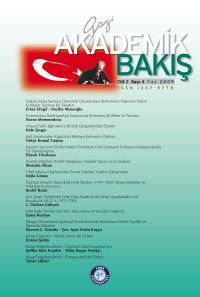Çivi Yazılı Tabletlere Göre Eski Anadolu’da Vergi Uygulamaları Ve Kaçakçılık (M.Ö. ± 1975-1750)
Tax Implementations and Smuggling According to Cuneiform Tablets in Old Anatolia (B.C. ± 1975-1750)
Author(s): L. Gürkan GökçekSubject(s): History
Published by: Gazi Akademik Bakış
Keywords: Old Anatolia; Cuneiform; Tax; Smuggling
Summary/Abstract: Tablets of cuneiform writing remaining from the period named as “Assyrian Trade Colonies Age” of the second millenium B.C. to the present-day are the oldest written sources which enlighten the Anatolian history. Almost all the tablets are about the doings of Assyrian merchants who came to Anatolia on business purposes. For that reason all the information we obtain about the said period of Anatolia deals with the economic life. According to the information given by those cuneiform tablets which are written in the old Assyrian dialect and about 25 thousand in number for today, the trade activities were being carried out in exchange of taxes levied by the Anatolian city chieftains and on condition that the merchants should obey some other regolations. From the tablets it is possible to determine the names and the characteristics of different kinds of taxes implemented in those days. Smugling was being comitted by means of bringing the commodities in the cities without getting permission from the local rulers or using awkward routes outside the human settlements not to pay taxes. Buying and selling the goods that are subject to the prohibition of trade was another means of smuggling.
Journal: Gazi Akademik Bakış
- Issue Year: 2009
- Issue No: 04
- Page Range: 147-157
- Page Count: 10
- Language: Turkish

